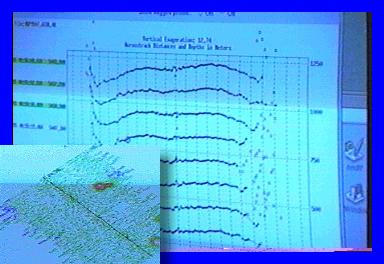
|
|
17 April, 1999
Dear Friends and eXtreme Science enthusiasts:
I was sitting on one of the aft decks, watching the swelling of the waves
when two trains of thought materialized in my mind:
I was thinking of a night out in Punta Arenas earlier this week where the
scientists gathered around the table. I leaned back in my chair and
watched them as they shared one of the lighter moments of the trip, these
people who have devoted themselves to exegeting the wonders of our world,
the passages of God, as it were, written in waves, currents, rocks, and
temperature gradients of the sea. They laughed and joked, leaning over the
table toward one another, imploring of each other this or that concession,
pleasantly unmindful, it seemed to me, of their role, the gravity their
calling had, and so perhaps were many, unaware of the implications of the
work of so many scientists over time, resulting in safer lives,
conveniences, and the pure Socratic pleasure of enlightenment to the
functioning of our world.
I was again struck by the will of the water . . . whereas a river is kind,
allowing a vessel to rest in her cradle, but the ocean is like a beast,
pushing and toying with your craft, testing its strengths, its weaknesses,
lifting on a whim, pushing her to the side, washing over her high rails
without so much as asking permission. There is no question here as to who
is the guest of whom. Yet, weíve come to make requests of this sea, to
bide and borrow time on her surface, to ask her for her secrets, to measure
densities and temperature differences, to split hairs with her over the
differences of a hundredth of a degree Celsius or the difference in the
shade of manganese on the order of a billionth of a molar. All of this
without evoking her unrest, her impatience. Yet this is what is required
to tickle her into surrendering the whereabouts of the vent sites she has
hidden for so long, so well. And this is required to gauge our world, to
know how much it has to offer, what the limitations of these offerings are,
and how well buffered it is against the ongoing stress that humankind puts
on her systems, and thus, to learn what is involved in achieving a
sustainable life in an ever complexifying world
Our journey from Punta Arenas to our first station off Elephant Island will
take 3 days at 11- 12 knots (Does anyone know the historical significance
of Elephant Island? What is the relationship between knots and miles per
hour? What about distances like nautical miles and fathoms? Why specify
"nautical?"), so we have some time to make each otherís professional
acquaintances. Today we were treated to a tour of the various lab stations
which will be in use during the mission for various analyses (Iíll try to
detail each of these in the upcoming days). Following the tour, we met
for a talk by Dr. Franz Smith, an ecologist from the New Zealand University
of Otago (now at Universidad de Chile). He spoke on the biodiversity that
exists on the submarine rock walls of fjords and the interactions with the
physical conditions (salinity, current rate, water movement, and rockslides).
Following these talks and lunch, more time was spent ping editing and
querying officers of the bridge as to our whereabouts and progress. I
learned here from several animal identification books on hand that the type
of marine mammal seen escorting the ship yesterday was an hourglass dolphin
(or sea skunk).
Until tomorrow,
Shawn Beightol

When the ships sonar data comes in, there are obvious data anomalies - reflections from things other than the sea floor (use your imagination...) as well as inteference from the ship's structure itself. We each must take turns each day review data and editing out the obvious discontinuous data, represented in the larger picture as individual lines (each line represents a signal sent at a given time, the line is composed of individual points from the different receivers). Once these lines of data are edited, they can be put together to form the surface map of the ocean (inset picture).
Contact the TEA in the field at
.
If you cannot connect through your browser, copy the
TEA's e-mail address in the "To:" line of
your favorite e-mail package.
|
